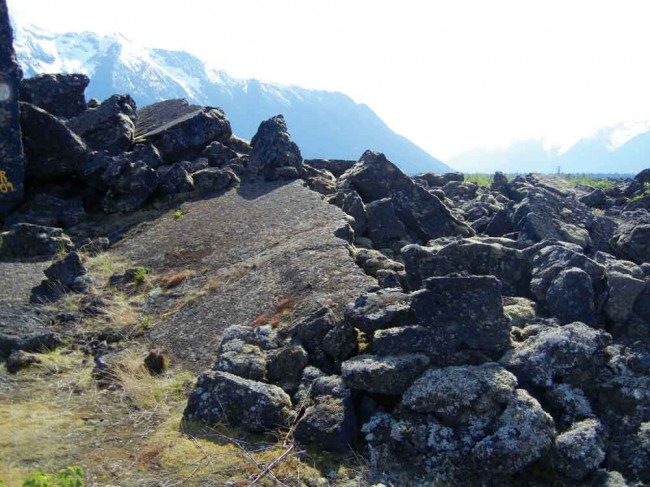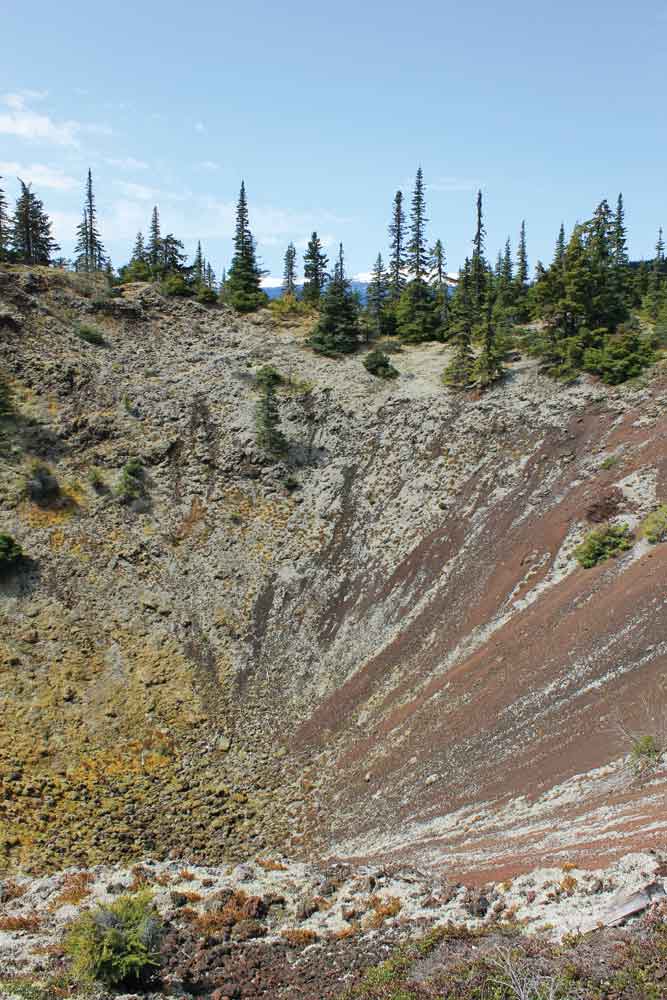
Photo Credit: Joanne Campbell
Nass Valley volcano: Tseax crater and Nisga’a Memorial Lava Bed Provincial Park
As a child, I was terrified of volcanoes. Every eruptively-colourful sunset would send me cowering under my bed like a citizen of Pompeii. Skip ahead many years and imagine my surprise that one of Canada’s most recent volcanic eruptions—and its most deadly—happened just a few hours down the road from where I live. What better way to exorcise old fears than to hike up a cinder cone to stare down a crater or stand atop a field of black lava?
The Tseax Cone and Nisga’a Lava Bed Memorial Provincial Park are situated in the Nass Valley, just over an hour’s winding drive north of Terrace on Nisga’a Highway 113.
There are several ways you can experience the park: just drive the highway and be amazed at the alien expanse of the lava beds that stretch on for kilometres. If you prefer a bit more structure and information, take the do-it-yourself Nisga’a Memorial Lava Bed Park Auto Tour: pick up your self-guided brochure at the Nisga’a Visitor Centre at the campground on Hwy 113, the Nisga’a Lisims government office in New Aiyansh, or the Terrace Visitor Centre. If you want to include the Tseax crater in your exploration, you’ll need a guided tour; check with the visitor information centres for details. Fully guided tours of the entire Tseax volcano system are also available.
My friend Sandra and I joined Nass Valley Tours owner-operator Steven Johnson and Lands Manager for the Nisga’a Lisims government, Mansell Griffin, for a guided tour to the Tseax crater.
The eruption
The Tseax volcanic eruption happened approximately 250 years ago, in the mid-to-late 18th century.
Standing on the lip of the crater, Griffin tells how the lava flow blocked Tseax Creek where it came out of what is now Lava Lake, enlarging the lake to its present size. Lava then ran down Tseax Valley until it hit the Nass River, which it pushed across the valley, redirecting the river from the south side to where it is now. The lava continued down the valley, eventually stopping near Gitwinksihlkw. From start to finish, the flow is about 20 km long and covers about 40 square km.
As Johnson explains, lava engulfed villages along the Nass River; although the flow was travelling too quickly to be outrun, it was toxic fumes and generalized chaos that killed an estimated 2,000 people. Nisga’a oral history notes that only four people from the affected villages survived. Today’s Nisga’a are descended from survivors whose villages were situated outside the Nass Valley. Eventually, the Nisga’a resettled on the north side of the Nass at Gitwinksihlkw (Canyon City) and Gitlaxt’aamiks (New Aiyansh).
Tseax volcano crater: Laxmihl, Where the Fire Ran Out
This 100-metre-high cinder cone is where the eruption began.
Hiking to the cone takes about four hours round trip and the guided tour starts at the park’s visitor information centre on Highway 113. After driving to the trailhead, your guide will lead you along a mossy trail through a mature forest of towering hemlock, cedar, spruce and balsam. Devil’s club and berry bushes congregate at stream crossings.
At Melita Lake, the scenery changes from the forest’s cool shelter to a rubble field of moss and lichen-covered lava boulders; pumice crunches underfoot as your guide reminds you not to stray from the path. Mosses hide thin spots in the lava crust where a hiker could fall through; the crust’s edges can be sharp as glass. The three-kilometre trail is through thick forest and crosses fast-flowing streams and steep, slippery slopes. Black bear and grizzly are plentiful in the area.
Staying on the trail isn’t just for your protection. The lava bed’s ecosystem is fragile and can be damaged by people walking off-trail through the slow-growing lichens. Also, as Griffin explains, “Nisga’a are animists. Everything has a soul, even the creek. Be careful walking because even the rocks have souls.”
After you turn left on the highway that leads to Gingolx (Kincolith), you see the lava bed’s expanse as it flooded the broad valley. This portion is 10 km long and three km wide. In places it looks like an epic bulldozer bucked up a giant parking lot, leaving slabs of blacktop stacked in random heaps beside the road.
Stop at the Nisga’a Memorial Lava Bed Provincial Park sign and walk around. You’ll see lichens making soil from rock, right before your eyes. Watch closely—and be very, very patient.
It’s tempting to take a souvenir, perhaps just a little piece of pumice as a reminder of this exceptional place, but the Nass Valley Tours website requests that you don’t: “We honour the stories and legends passed to us by our ancestors. For each of our generations we have honoured the passing of the 2,000 Nisga’a buried beneath the surface of the lava to the point we consider each and every rock as part of their collective headstone or grave marker. For that reason we ask that you do not remove the lava from the park.”
Nisga’a oral tradition
At least as important to the Nisga’a as geological events is their account of the eruption as it has been preserved by oral tradition. Each Nisga’a house has its own version of the eruption story that agrees with the others on basic details, but vary in the way it is told. Among coastal First Nations, stories are sacred and may not be shared without permission. This version of the eruption event, from the Nisga’a oral tradition, is found on the Nisga’a Lisims government site:
Long ago, two children were playing down by the river. One child caught a salmon and slit open its back. The child stuck sticks into the salmon’s back, set them on fire, and returned the fish to the river. The children were amused to see the salmon swim erratically, smoke rising from its back. The other child caught a salmon and slit open its back, inserted a piece of shale, and put it back into the river. The salmon floated on its side, weighed down by the shale. The children laughed at the struggling fish. An elder happened upon the scene and warned the children, “Take care what you do. The salmon will curse you and the Creator will respond in kind.” The ground began to tremble and shake. Nature’s harmony had been upset. A scout was sent to investigate. From the top of Gennu’axwt, he saw smoke and flames and ran to warn the people of their fiery destiny. In panic, some villagers fled up the mountain. Others canoed to the far side of the river but were killed by the lava. As the people watched the lava flow over their villages, Gwaxts’agat (a powerful supernatural being) suddenly emerged to block the lava’s advance. For days, Gwaxts’agat fought back the lava by blowing on it with its great nose. Finally, the lava cooled and Gwaxts’agat retreated into the mountain where it remains to this day.
Nisga’a culture was profoundly affected and shaped by the Tseax eruption: villages were destroyed and the salmon run was disrupted for years. The cautionary tale embedded in the account is a reminder to honour the wisdom of your elders and respect the sanctity of the salmon.
“Salmon were to us much like Christ was in Christianity. If you’re a Christian you believe Christ came to earth to die and save everybody from damnation. It’s through his death that Christians are saved,” Griffin explains. “Well salmon, we believe, did that every single year. Over and over and over again. Not just once every 2,000 years, but every year. Salmon come up the river knowing that we’re going to catch them because it happened last year. Their spirit never dies.”
The Nisga’a believe that when salmon do die and their meat is eaten, their spirit goes back to their village underneath the ocean so they can return the following year. Being animists, they believe that if the fish are hurt, the people won’t be deserving and the salmon will no longer return.
Maybe in the same way I’ve returned to face my fears, peering into a volcanic cavity and finding myself renewed. Perhaps not Christ-like (or even salmon-like) but with a new appreciation for the history, cultures and natural phenomena that surround us here in northern BC.
For more information
There’s much more to the Nass Valley than a volcano and lava beds, but food and accommodation or camping facilities are limited. If the campground is full and local resorts are booked, you can set up basecamp in Terrace and explore the Nass in day-trips. Pack a cooler with picnic supplies and drinks.
For more information on the Tseax Cone and the Nisga’a Memorial Lava Bed Provincial Park, and the variety of attractions the Nass Valley has to offer, check out these websites:
en.wikipedia.org/wiki/Tseax_Cone
en.wikipedia.org/wiki/Nass_River
www.env.gov.bc.ca/bcparks/explore/parkpgs/nisgaa/
www.env.gov.bc.ca/bcparks/explore/parkpgs/nisgaa/












I’ve seen the lava beds. They are humbling and amazing and we’ll worth the drive there from Terrace.
👤 Derek Young 🕔 Jul 14, 2015
Born and raised in the Terrace area. Spent a lot of time walking the lava beds and enjoying the lake. Brings back great memories, as I settled in the lower mainland of Vancouver many years ago
👤 Ron Cole 🕔 Dec 16, 2016
We visited this park in 2001.As I grew up in a city built on a field of 53 dormant volcanoes I can appreciate the power that formed these lava beds. When Mother Nature decides to have a “hissy fit” She sure does it in style! Loved every minute of exploring around here. Would love to come back
👤 Julie Pearce 🕔 Mar 21, 2017